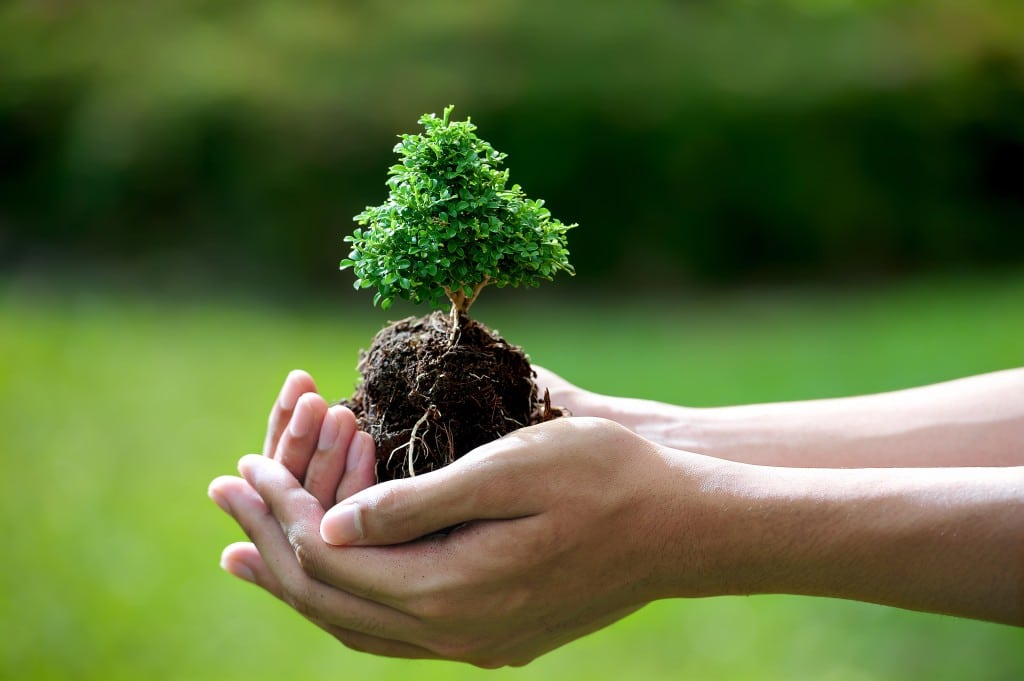When it comes to the Japanese art and science of Bonsai, it uses masterful and careful pruning, training, and care techniques, creating a miniature version of a wild tree, yet naturally realistic and beautiful plant.
As contrary to the most popular belief, a bonsai tree is not a specific species of a dwarf tree. The fact is any tree species can be cultivated, trained, and grown to become a beautiful bonsai.
In Japan, the Sandai-Shogun-no-matsu in the famous Tokyo Palace refers to a white pine type of bonsai tree, which is believed to be more than 500 years old. It is considered the oldest known and existing specimen of bonsai worldwide.
It takes a great amount of discipline and skill to attain the ideal form and shape of a bonsai tree. It is not enough to simply plant a tree in a small bonsai pot, water, fertilize, and occasionally prune because caring for a bonsai tree needs your time, patience, and utilization of resources regardless if it is indoor or outdoor bonsai growing.
In this article, we will share a tutorial about taking care of bonsai trees to make them live for hundreds of year. Here are the topics we will cover:
- Basic Guidelines When Caring and Growing Bonsai
- Bonsai Soil and Orchid Mix
- Watering Your Bonsai Correctly
- Feeding and Fertilizer Tips and Considerations
- Repotting Guide
- Containers or Pots Guide
- Tools and Supplies Needed for Bonsai Growing
- Most Common Bonsai Pests and Diseases
Whenever people hear the word “bonsai”, they’ll start to think about growing a small tree in a small pot. Bonsai trees are always connected with Asian culture.
However, those who are aware and knowledgeable about the art and science of bonsai trees know that it’s more than just “small trees in small pots”.
It is something that requires a great deal of time, care, and dedication. Let’s start the tutorial now!
Basic Guidelines When Caring and Growing Bonsai
a) Soil and Orchid Mix
One of the most common conditions that are completely within the control of a bonsai gardener is the soil type in which the bonsai tree is planted. The type of soil can also be an issue among bonsai gardeners. Pre-mixed soils are considered the best, but are generally expensive and anyone with numerous smaller ones or a large tree could be apprehensive, most especially for a new bonsai tree.
b) Watering Bonsai Trees
There are important factors to consider when watering bonsai trees such as the climate, bonsai tree species, and bonsai tree size. You need to monitor the amount of water that your bonsai tree is receiving. Your bonsai tree soil should stay moist but not oversaturated because it can cause the root rot and decay.
c) Bonsai Tree Feeding and Fertilizers
Bonsai trees are placed in small pots, so they need to be regularly fertilized to ensure that they are not deprived of all the essential nutrients they need to survive. The three macronutrients that bonsai trees need include nitrogen, phosphorus, and potassium. Nitrogen enhances the growth of the leaves and stems, phosphorous boosts the healthy growth of the roots, and potassium increases the growth of flowers and fruits of specific bonsai tree species.
d) Bonsai Tree Repotting
It is important to regularly repot your bonsai tree to ensure it doesn’t starve and get root bound or pot bound. By repotting your bonsai tree, you can guarantee that your bonsai will continue to grow and flourish. Your decision to repot a bonsai tree usually depends on the pot size used and the bonsai tree species. More mature bonsai trees are usually repotted every three to five years whereas fast growing bonsai trees need to be repotted once every two years.
e) Bonsai Tree Positioning and Location
It’s very important to look for the specific information about the proper placement and position of the bonsai tree because every bonsai tree is different. For your outdoor bonsai trees, you can position them in an area that gets plenty of sun for most parts of the day, but they should still need to get an ample amount of shade. Indoor-kept bonsai trees should be put in a bright spot in the home. There are indoor bonsai trees requiring direct sunlight while others require some shade.
f) Bonsai Tree Containers and Pots
By choosing the right pot or container for your bonsai tree is considered as one of the initial and most important steps when it comes to setting up a bonsai. Selecting the right container or pot needs keeping important concerns in mind. Planting a bonsai tree in the smallest pot size possible is crucial when selecting a pot. It should be large enough to hold the bonsai tree and allow its roots to healthy and steadily growing, but small enough for confining and controlling its growth so it’s limited to that pot for a longer period of time.
g) Bonsai Tree Pests and Diseases
Bonsai trees, like any other trees and plants, are also susceptible to most common pests and diseases. Because most bonsai trees grow in an outdoor garden some species, like quince, are more susceptible to weak roots and are prone to damage. The pathogens or harmful microbes can enter through these damaged areas that can kill your entire bonsai tree.
h) Bonsai Tree Care Tools and Supplies
You need to invest in some basic tools and materials to maintain and properly care your bonsai tree, crafting it to a beautiful art piece. These materials may include pots, fertilizers, humidity tray, and moisture meter, a device used in measuring the amount of water in the soil.
Growing Bonsai Trees Indoors
Indoor bonsai trees are sensitive and very delicate. They need attention and special care. Growing and caring for bonsai trees can be a daunting task. Bonsai growers should be knowledgeable about the basic concepts of bonsai care to avoid a mess on their bonsai project.
Growing Bonsai Trees Outdoors
Caring for bonsai trees outdoors is not difficult but it’s essential to keep your bonsai tree happy and healthy for the coming years. Bonsai trees have a dormant season during winter months. They need cold or cooler temperatures during the dormancy period. It means that you can’t take your bonsai tree inside your home when the weather starts to cool off because it needs the dormancy period for healthy growth and development.
Conclusion
These are a just basic guideline when it comes to caring for your bonsai tree. In the next upcoming sessions, you’ll get a deeper sense of perspective about every essential aspect of bonsai care.
2) Bonsai Soil and Orchid Mix
The use of the correct soil mixture is crucial for the proper growth and development of your bonsai trees. The soil is essential in supplying the bonsai trees with the essential nutrients they need. The soil needs proper drainage, enough aeration and water retention. Bonsai shops are selling ready-mixed soils, but you can also create yours to save money and enable you to adjust mixtures per species of a bonsai tree.
The quality of bonsai soil that you use for your bonsai tree directly affects its vigor and health. Unhealthy bonsai trees lack vigor and are usually planted in organic or poor bonsai soil. Some are planted in normal plant garden soil that easily hardens whenever it gets dry. This is very harmful to the bonsai tree.
Qualities Required in a Good Bonsai Soil Mix
a) Good Water Retention
The bonsai soil you use needs to hold enough quantities of water so your bonsai tree will be supplied with the needed moisture in between watering.
b) Good Drainage
Any excess water should drain immediately and easily from the bonsai pot. A soil that lacks good drainage is highly water retentive, lacks aeration and is liable to salt build up. When there is too much water retention, it will cause the bonsai roots to rot, thus killing the bonsai tree.
c) Good Aeration
It is important that the particles used in a given bonsai soil mix should be of enough size for allowing air pockets or tiny gaps between each particle. Aside from oxygen required for healthier roots, it’s also important to have good bacteria and intact mycorrhizae, for the proper processing of food prior to root absorption and sending water and nutrients to the leaves for the production of energy or what is called as photosynthesis.
A particle-based and well-structured inorganic soil promotes faster drainage of water, allowing fresh air to enter the bonsai soil continuously. A compacted organic bonsai soil lacks structure, aeration, and proper drainage, leading to the root rot and ill health.
Organic or Inorganic Soils
When it comes to bonsai soil mixes, they are described as either organic soil or inorganic soil. Dead plant matters like bark, leaf-litter, or peat are considered as organic soil components.
Organic soil components break down over time, reducing water drainage. Most bonsai potting composts, absorb water poorly if dried completely. This is considered as one of the major problems of cheap bonsai trees bought at garden centers. A bonsai gardener thinks that his bonsai tree is properly watered but the water actually runs past the soil towards the bottom of the bonsai pot.
When it comes to the inorganic bonsai soil components, they contain minimal to no organic matter like volcanic lava, baked calcite, or fired clays. They tend to absorb less water and nutrients as compared to organic soils, but they are great for aeration and drainage.
Bonsai Soil Components
Bonsai soil mixtures have important components including akadama, lava rock, pumice, fine gravel, and organic bonsai potting compost.
a) Akadama
It is a hard-baked Japanese clay that is specifically produced for bonsai purposes and it is available in bonsai shops. Akadama needs to be sifted before it is used. Just bear in mind that after two years, akadama will start to break down, thus, reducing aeration to some extent. It will require regular repotting or it should be mixed with soil components that have a good draining quality.
Akadama is expensive so other bonsai growers replace it with similar baked or fired clays which can be purchased at garden centers. You can also replace akadama with cat-litter.
b) Pumice
It is a soft volcanic product, absorbing nutrients and water quite well. When pumice is used in a bonsai soil mix, the water is retained. It also helps the roots to properly ramify.
c) Lava Rock
It retains water. It adds a good structure when it is part of a bonsai substrate. But remember that bonsai roots cannot grow into Lava rock.
d) Organic Potting Compost
It includes peat moss, sand, and perlite. However, there are drawbacks like high water retention and poor aeration. But if it is used as a part of a mixture, organic potting compost can be used perfectly.
e) Fine Gravel or Grit
It helps in creating a well-draining and properly aerated bonsai soil. It is used in the bottom layer of bonsai pots, enhancing water drainage a bit further. Most bonsai growers don’t use grit anymore because they stick to a mix of Pumice, Akadama, and Lava rock.
Recommended Soil Mixtures for Bonsai
Different bonsai tree species require different soil mixtures. That is why it is important to make sure to check and find the optimum mixture for your specific tree. We have described here the two main soil mixtures for deciduous trees and coniferous trees. Both bonsai mixtures consist of pumice which is good for the substrate’s structure; akadama, which is the component for water retention; and lava rock for drainage and aeration.
Deciduous Bonsai Tree Soil Mixture
- 25% Pumice
- 50% Akadama
- 25% Lava rock
Coniferous and Pine Bonsai Tree Soil Mixture
- 33% Pumice
- 33% Akadama
- 33% Lava rock
Conclusion
Note that these bonsai soil mixtures should adapt to your local conditions. If you don’t have time to check on your bonsai trees twice a day, you can add extra akadama or organic potting compost based on your preference to your bonsai soil mix. Doing this will raise its water retention properties. If you are living in a wet climate, you can add more grit or lava rock to help enhance the water draining qualities of the bonsai soil mixture.
3) Watering Your Bonsai Correctly
There is no golden rule about the most preferred time to water a bonsai tree. You need to avoid watering your bonsai trees during afternoon using cold water because the soil will cool down quickly because the bonsai soil has been warmed up by its exposure to sunlight. Although this is an important consideration, you can water your bonsai trees any time when the bonsai soil is slightly dry.
When the bonsai soil is still wet, you should not water your bonsai tree. Just do it whenever the soil feels or looks slightly dry. There are effective methods you can use if you want to check the soil’s moisture levels or dryness. Don’t allow your bonsai tree to completely dry out. As you become more experienced, you’ll be able to determine when your bonsai trees need watering rather than feeling the soil to check the dryness with your hands.
Just bear in mind, not to water your bonsai trees on a routine schedule. It is best to observe your bonsai trees until you know that it’s slightly dry. There are important factors that you need to take into consideration on the frequency of watering your bonsai trees, and following the correct guidelines will help in making your bonsai trees happy and healthy as you provide them enough water they need.
How to Check Soil Moisture
You need to check the bonsai soil on a daily basis to know if it’s time for you to water your bonsai trees. The factors affecting the frequency of watering your bonsai trees varies depending on the tree species, the pot size and type, and the location of your bonsai trees. Here are the ways to check soil moisture.
a) Soil Moisture Meter
Whether you are a bonsai expert or a novice, a moisture meter is a very important tool you can use instead of guessing every time.
A soil moisture meter can measure the moisture of the soil at the root level. It helps prevent underwatering and overwatering. The scale of a moisture meter ranges from 1 as the driest to 10 or the wettest.
b) Finger Method
Just simply stick your finger or fingers to check the soil moisture about 1 inch deep. However, it can be difficult to gauge a moist soil if it feels very cold. It’s also messy and bit off after you already have tested several bonsai trees.
c) Chopstick Method
You can use plain and unstained wooden chopsticks, tongue depressor, or popsicle stick to perform this method. You can do this by inserting the chopstick into the soil at 1 to 2 inches deep. You can check the bonsai soil moisture of all your bonsai trees at the same time, but use different chopsticks to prevent contamination.
It is also possible to check the moisture or dryness of the soil by lifting the bonsai pot. However, this is only applicable for smaller bonsai trees that are not more than five gallons. It takes the experience to acquire your skill in feeling and looking at a dry soil.
Different Ways to Water Your Bonsai Trees
a) Watering Bonsai by Rainfall
You can follow the old practice of Japanese about caring and watering bonsai trees. It mimics the natural rainfall. Let the water soak the bonsai soil for 15 to 20 minutes then soak the soil again until the water runs out from the drainage holes. The natural watering made by rainfall is very good for your bonsai trees.
b) Water Hoses and Watering Cans
Using an overly concentrated pressure or stream of water may wash out the soil. If you only have a small bonsai collection, it is best to use a small watering-can fitted with a fine rose, which is enough to thoroughly water the bonsai soil without displacement. If you want to use a water hose, just use a low-pressure, shower, or mist setting. You can also use a water hose fitted with a spray gun.
c) Drip Irrigation Systems
Drip irrigation systems can be used in watering your bonsai trees with automatic drip system and timer.
d) “Dunking” Your Bonsai or Watering by Immersion
Watering bonsai trees by dunking or immersion can also be done. This is a quick fix if your bonsai tree is total.
Just take note that frequent dunking may result to compact soil causing root damage. If you need to regularly immerse your bonsai tree, it means that your bonsai tree needs repotting or placed in a different soil mix.
Watering Bonsai Trees Step-by-Step Guide
Step #1: Check the dryness or moisture of the soil using a moisture meter. If you don’t have this device, you can do the finger method or the chopstick method. After determining that the soil is slightly dry about 1 inch deep, you can proceed with the next steps.
Step #2: Prepare all the things you need such as water hose, water can, and the suitable water ideal for your bonsai. Tap water usually works except for hard water. You can add lime and let it sit overnight before using a hard water.
Step #3: Watering your bonsai trees from the top with the use of water hose with a fine nozzle is preferred to prevent washing away the bonsai soil. Continue watering until the water comes out from drainage holes of the pot. Be sure to thoroughly water your bonsai trees until their entire roots system is wet.
Step #4: Water your bonsai tree after a few minutes as necessary.
Watering Facts and Tips
- It is not necessary to water your bonsai trees every day. Just check the soil first to find out the moisture level or dryness, and water your bonsai tree if it feels slightly dry or the moisture meter shows a scale of 3 and below.
- Water your bonsai trees using a plain tap water. If you are using a hard tap water, it helps occasionally watering your bonsai trees with rainwater to eliminate any soil salt build up.
- Never water your bonsai trees using a water hose that has been exposed under the sun. Run water through the hose for a few minutes to cool it off.
- Never hit the flowers and fruits when you are watering your bonsai trees. Doing so may kill the flowers and fruits.
- Every bonsai tree species is different from the other. The schedule for one bonsai tree may not be applicable for the other. It is best to check your bonsai trees daily to accurately determine its watering needs.
- Allow the bonsai soil to dry slightly in between watering to ensure that you are not administering too much water or overwatering your bonsai trees. Overwatering is fatal to bonsai trees.
Conclusion
Watering your bonsai trees needs knowledge and skills, and it should be performed whenever the soil feels or looks slightly dry. Bonsai masters took years to learn the skills of checking soil moisture by looking at the soil alone.
4) Feeding and Fertilizer Tips and Considerations
Bonsai trees also need fertilizer. Bonsai fertilizers may come as solid or liquid fertilizers. When it comes to bonsai organic fertilizers, the most popular ones are cottonseed meal, seaweed-based fertilizers, and fish emulsion. The major nutrients that bonsai needs include nitrogen during the growth period, phosphorus for healthy flowers and fruits, and potassium for general health. Bonsai fertilizers are available in gardening stores and bonsai online shops.
What You Need to Prepare
When it comes to feeding bonsai trees, you’ll need the following:
- Preferred fertilizer
- Tea bags
- Measuring cups for liquid fertilizers
- Baskets for solid fertilizers
Tips When Feeding Bonsai Trees
Tip #1: The container soil mixes of bonsai trees don’t usually contain enough fines or clay for holding nutrients, so they should be fertilized regularly and abundantly to make up for it. Bonsai mixes usually have a poor nutrient holding capacity that requires continuous feeding.
Tip #2: If you are growing bonsai trees in a sandy loam, there’s a reduced need for watering and fertilizing. It’s can be hard to set a formula due to the several factors involved. Determine if your bonsai tree has good nutrition through its leaf color, general appearance, and growth.
Tip #3: The bonsai roots take up essential nutrients and water. The root system is far more efficient than the leaves. When you apply fertilizer to the leaves, the roots will take the nutrients up and store more nutrients needed. Foliar feeding is acceptable as long as the water runoff from the root ends.
Tip #4: Don’t over fertilize your bonsai trees because it will result in salt burn causing browning of leaves and drying of plant and soil.
Tip #5: Fertilizing is required for your bonsai trees to remain healthy. Bonsai trees grow in a small amount of soil in a pot, so you need to replenish the nutrient supply periodically. Fertilizers should use half of their suggested strength. Fertilizers are generally applied to bonsai once a month except in winter.
Bonsai Fertilizing Step-by-Step Guide
Step 1: Choose a bonsai tree you need to fertilize.
Step 2: Choose a fertilizer with the balanced NPK ratio.
Step 3: Place solid fertilizers in mini baskets to ensure they’re not consumed by birds or washed away when you water your bonsai trees.
Step 4: Mini baskets are positioned on the soil surface.
For Liquid bonsai fertilizer…
Step 1: Prepare your bonsai tree you need to feed.
Step 2: Choose a liquid fertilizer with a balanced right NPK ratio.
Step 3: Read the instructions carefully on the label of the liquid fertilizer.
Step 4: Spray liquid fertilizer to your bonsai tree.
Conclusion
Whenever you apply fertilizer, make sure to read the instructions on the label of the fertilizer bottle to prevent overfeeding or underfeeding of your bonsai trees. There are highly recommended nutrient levels for different seasons as well as stages of growth and development of bonsai trees you need to take into consideration.
5) Repotting Guide
Repotting helps in replacing or replenishing your bonsai its compost soil. A typical tree has the ability to extend its roots deep into the ground and its surrounding areas to find the necessary nutrients and enough water to survive. However, bonsai trees are confined in small containers or pots with very little soil, so they’re depleted with nutrients very fast.
Best Time to Repot Your Bonsai
The perfect time to repot your bonsai tree depends on the species, health, age, a rate of growth, and size of the pot. For younger and actively growing bonsai trees, they need more frequent re-potting as compared to mature and older trees.
If ever your bonsai tree is growing vigorously, you should replant every 1 to 2 years to avoid pot or root bound. For slow-growing bonsai trees, they need to be left for 3 to 5 years. Repotting should be done during just before or early spring as soon as the bonsai buds open.
Things You’ll Need When Repotting
When repotting a bonsai tree, it is considered a very delicate procedure since the roots tend to dry out very fast. You need to gather all the materials first and assemble them ahead of time.
Here are the things you’ll need:
- Good working area
- New bonsai pot
- Bonsai Soil
- Root hook or root –for untangling the root balls and removing old soil.
- Sharp bonsai cutters or shears for root pruning
- Mesh- drainage holes cover.
- Wire- to secure your bonsai tree into the pot.
- Chopsticks or pencil- for removing air pockets from the new bonsai soil.
- Water bottle- used for spraying roots.
Step #1: It is important to determine the best time to repot your bonsai tree. To determine the presence of rootbound, just lift your bonsai tree carefully. If the roots encircle the inside of the put and around themselves, then it’s time to repot.
Step #2: Remove the old bonsai soil as much as you can from the bonsai roots. Knock as much soil bonsai soil out of the roots with the use of a root hook, gently disentangling the bonsai roots if they have grown thickly.
Step #3: After you untangle the roots of the bonsai, prune the longer roots to keep the bonsai tree from outgrowing the pot. It’s helpful to rotting or sick roots. Do not remove more than 25% of total root mass to ensure that there are enough roots left for proper nutrient and water absorption.
Step #4: Reposition the bonsai in the pot or container. When the bonsai roots are trimmed, carefully lower your bonsai tree back into the pot. Fill the pot to the brim with the preferred potting mix. Work into the soil and the root structure to prevent air pockets to be left behind in between the bonsai roots.
Generally, a bonsai potting mix consists of gravel, akadama, and bonsai soil compost in a 2-1-1 ratio. Akadama pertains to a granular clay produced for bonsai potting or re-potting. Make some adjustments basing on the location’s climate and tree species.
Step #6: Water bonsai trees after repotting to help the bonsai compost soil settle. Keep the bonsai trees protected against strong winds for at least a month after repotting.
Conclusion
Bonsai trees prevent rootbound. Bonsai trees will be healthy and stronger with new bonsai soil because nutrients are replenished. You have just learned the important information about repotting bonsai trees.
6) Containers or Pots Guide
Bonsai pots come in different shapes, sizes, and colors. Bonsai pots differ from ordinary plants pots, serving as beautiful and effective pots for bonsai trees. They should have wiring holes to keep the bonsai trees fixed to the pots. The different materials for making bonsai pots include plastic, wood, concrete, porcelain or ceramic, metals, mica, clay, or stoneware.
Remember that metals release toxins, that’s why you need to use ceramic or porcelain as the best option. Bonsai pots are available in bonsai garden centers and bonsai online shops. Ceramic bonsai pot is a classic type of bonsai that is stoneware burned.
Tips for Choosing Bonsai Pots
Tip #1: Always prioritize the health of your bonsai trees. Finished and mature bonsai trees usually have years of training, so they are established and can adapt well to smaller pots. Caring bonsai requires patience, perseverance, and hard work, and so you need to also apply these qualities when choosing the right bonsai pots for your bonsai trees.
Tip #2: The required measurement is crucial most especially the depth of the bonsai pot.
Tip #3: Bonsai pots should compliment with attributes of bonsai trees such as flowers, fruits, the texture of the bark, shapes, and sizes of needles and leaves, and the thickness of the bonsai trunk.
Tip #4: Bonsai pots that are glazed colored are highly recommended for bonsai trees with fruits or flowers. Evergreen bonsai trees, like pine and juniper bonsai trees, do good with gray and brown bonsai pots. Glazed bonsai pots are usually beautifully designed with flowers or birds.
Tip #5: Flowering bonsai trees are best complemented by glazed bonsai pots with soft hues such as green, cream or light blue. Unglazed bonsai pots come in different colors such as brown, gray, and red clay, are best in complementing evergreens and conifer bonsai trees and portraying the harsh environment of the bonsai tree’s natural habitat. Unglazed bonsai pots can emphasize the age of a bonsai tree or when it’s being used to express a relaxed atmosphere.
Types of Bonsai Pots: Display Pots and Training Pots
The two basic types of bonsai pots include display pots and training pots. Bonsai trees that are still in the training phase should stay in a functional and practical bonsai training pot. Display bonsai pots are made of wood, plastic, or mica. Bonsai training pots should have enough space for healthy and stable roots to achieve the desired trunk thickness. Bonsai training pots possess large drainage holes, so water will not pool at the bottom and to avoid waterlogging of the root system that can be fatal to bonsai trees.
After the training phase, and the bonsai has fully developed, it can be repotted in a display pot which is aesthetically appealing. Display pots are made of ceramic with a glazed or shiny finish or a matte or unglazed finish. They are also frost-proof and very attractive. Remember that when it comes to choosing a bonsai pot, it should not overshadow the beauty of a bonsai tree. Choose a display pot that can enhance the beauty of a bonsai tree.
Conclusion
Bonsai trees are unique and they’re considered as a piece of the art piece. They are decorative in nature and plays a major role in ancient tradition. Choosing the right bonsai pot depicts the real overall beauty of a bonsai tree. When selecting bonsai pots consider the bonsai tree size, species, and your personal preferences.
7) Tools and Supplies Needed for Bonsai Growing
Using the wrong bonsai tools may cause severe harm and damage to your bonsai trees. The main tool being used by bonsai gardeners when working on bonsai trees is a good pair of bonsai scissors. Unlike regular scissors sharpened with flat surfaces, bonsai scissors are designed to cut wires and branches without crushing or damaging bonsai trees. Never use a regular pair of scissors for your bonsai trees because they can be harmed or damaged.
The other bonsai tools you need to work on your bonsai trees include branch cutters, wire cutters, and wire pliers. Bonsai trees also need to have their older and sturdier branches regularly trimmed and this can be done using branch cutters. Bonsai wire pliers and wire cutters are valuable tools for shaping bonsai trees into beautiful masterpieces.
Materials and Tools for Maintenance
When removing dirt and rust on the tool blades, you can use rust erasers like Clean Mate. There are also different types of grindstones for sharpening tool blades. You can start to practice sharpening old and worthless or unused shears prior to sharpening your actual bonsai tools.
Disinfecting your bonsai tools should be done every now and then. Doing so will prevent the transfer of fungi, parasites, virus, or bacterial infections. Gun oil and camellia oil are used for the proper maintenance of blades and hinges. You can also use coco brushes to sweep soil surfaces, tables, shelves, tools, bonsai trunks, and Nebaris.
8) Most Common Bonsai Pests and Diseases
Like other trees and plants, bonsai trees are also at risk for pests infestations and common diseases. Bonsai trees also experience nutrient problems, root bound, root rot, potting issues, overwatering, underwatering, and pests infestations. Pests and diseases can be prevented by keeping your bonsai trees healthy because the health of a bonsai is influenced by the gardener’s cultivating techniques. It is important to apply careful bonsai management.
a) There are bonsai trees that are appealing to insects such as Fukien Tea bonsai trees. Mealybugs are and white fluffy soft insects like Fukien Tea which are seen on the new branches of bonsai trees and their leaves. Root mealybugs tend to live on the bonsai roots. They are not visible outside the bonsai pot except when repotting. The common treatment of root mealybugs includes using systemic insecticides. If ever your bonsai trees are inadequately treated, the nuisance mealybugs may cause major problems that can weaken your bonsai trees and eventually kill them.
b) The scale can attack your bonsai tree. Scales can be detected when your bonsai trees become sticky secretions that turn black when they’re colonized with mold or fungus. Scales are obviously recognized as black or brownish bumps on bonsai leaves and twigs. They can be easily dislodged from the branches of bonsai trees with a fingernail. The underneath bonsai leaves and stems may have soft tan insects or pink insects. Scales appear different to bonsai tree bark’s normal bumpy appearance.
c) Aphids are also called small and soft insects that are commonly found at the tips of bonsai branches and are usually accompanied by ants. They are treated using mild soap and water solution sprays that are sold at bonsai plant nurseries. You can also mechanically dislodge aphids and ants from the leaves and branches of your bonsai tree using a strong spray of water or a Q-tip soaked in rubbing alcohol.
Why Bonsai Leaves Turn Brown
There are many possible reasons why the leaves of a bonsai tree may turn brown. One of them is watering issues. Bonsai trees may die because of too much water or drowning or lack of water or dehydration. Overwatering and underwatering may cause the browning of bonsai leaves.
Signs of Bonsai Dehydration or Underwatering:
- Tiny creases on bonsai trunk indicate shriveling up.
- The bonsai soil feels dry and hard.
- A bonsai root system that is extended only means that the roots are trying to look for water so they venture wide and far.
Signs of Drowning or Overwatering:
- The bonsai roots may appear to be experiencing fungal infection or rotting as evidence by sticky and whitish secretions.
- The trunk part of the bonsai tree is soft.
- There’s very shallow root system (a possible sign that the roots were not able to find water).
- Tiny white appearance present in the soil, indicating fungus gnat larva, keeping the soil too moist, thus feeding on the smallest and finest feeder roots.
- The bonsai tree is no longer vibrant.
- Many bonsai leaves turn yellow or brown.
- Smaller bonsai branches may shrink.
How to Prevent Watering Issues
It is crucial to test the bonsai soil for dryness or moisture. You can simply poke your finger in the soil, and if it feels nearly dry or completely dry, then you need to water your bonsai tree. You’ll probably need to water your bonsai trees every 1 to 3 days. The best way is to check the soil using a moisture meter because it is more accurate with less mess, most especially if you’re working on numerous bonsai trees.
Conclusion
Regular visual inspection of your bonsai trees at least once a day greatly helps in diagnosing pests problems and early signs and symptoms of diseases. You can watch this video to have a better idea on how to detect common pests to grow healthy bonsai trees!
Final Thoughts
You just gained a comprehensive knowledge on caring for bonsai trees. By watering your bonsai trees correctly, proper fertilizing, repotting, using the right tools, and choosing the right pots, you can ascertain the health and long life of your bonsai trees. We hope you like this tutorial. You may share this information and comment your insights and feedback below!
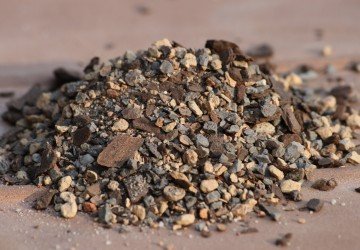
Soil & Orchid Mix
One of the conditions that is completely in the bonsai gardener’s control is the type of soil in which they plant their tree or shrub. Bonsai soils can actually be an issue among gardeners. Many believe pre-mixed soils are the best, but they are expensive per pound and anyone with a large tree or numerous smaller ones could be apprehensive, especially with a new tree.

Watering
When it comes to watering bonsai trees, how much and how often it is watered is based on a large number of factors, including the climate, size of the bonsai tree, and of course the bonsai tree species. Individuals need to monitor the water amount in the bonsai tree. The bonsai tree soil should always be moist but it should not be oversaturated as this can cause the roots to rot and decay.
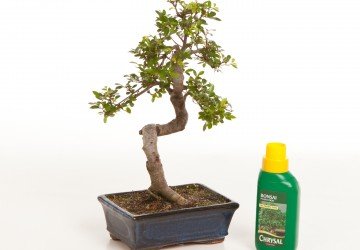
Feeding/Fertilizer
Because a bonsai tree is placed in a small pot, it is necessary to regularly fertilize the bonsai tree to ensure that it continues to get all the essential nutrients. There are three primary nutrients – nitrogen, phosphorus, and potassium. The nitrogen enhances stem and leaf growth, phosphorous boosts health growth of the bonsai tree roots, and potassium increase the growth of any flowers or fruits that bloom on the bonsai tree.

Repotting
Regular re-potting of a bonsai tree is essential to ensure the bonsai tree does not starve and get pot bound. By repotting the bonsai tree, it will guarantee the bonsai continues to flourish and grow. Repotting a bonsai tree often depends on the bonsai tree species and the size of the pot being used. Bonsai trees that are fast growing require re-potting once every two years; while more mature bonsai trees can go three to five years before needing to be re-potted.
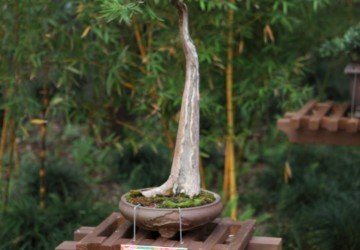
Positioning/Location
It is important to look for specific information regarding where to position the bonsai tree as every bonsai tree species is different. For outdoor bonsai trees, it is best to position them in a spot that gets lots of sun for parts of the day, but still ample amount of shade as well. Bonsai trees that are kept indoors should be put in a bright location in the home. Some indoor bonsai trees require an abundance of direct sun while others need some shade.

Containers/Pots
Selecting the right pot for your tree and décor is one of the first and most important steps in setting up the bonsai. Picking the right pot requires the gardener keep several concerns in mind. Planting in the smallest size possible is important when choosing a pot for the bonsai. The pot has to be large enough to adequately hold the plant and allow its roots to grow steadily, but small enough to confine and control the growth so it is limited to that container for a long time.

Pests & Diseases
Bonsai are susceptible to pests and diseases, as most of them grow in an outdoor garden rather than an indoor one. Some species, including quince, are more susceptible to disease as their root systems are weak and prone to damage. Harmful microbes enter through the damaged areas.

Tools & Supplies
While a plethora of materials and tools are not required, some basic materials and tools are needed to maintain the bonsai tree and craft a beautiful one. Materials for a bonsai tree include pot, humidity tray, a device to measure the water amount in the soil (rather than the chopstick method discussed above), and fertilizer.
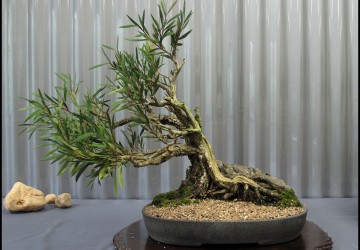
Indoor Bonsai Care
Indoor bonsai trees are very delicate and sensitive. They require special care and attention. Growing a bonsai tree can be a very daunting task. Growers should know some basic concepts so they won’t mess up their very first bonsai project. This will help people take care of indoor bonsai trees and ensure perfect growth.

Outdoor Bonsai Care
Caring for your outdoor bonsai tree is not difficult but it is necessary to keep your tree healthy and happy for years to come. Your bonsai has a dormant season during the winter months and needs cold or cool temperatures during dormancy. This means you can’t take your bonsai inside your home when the weather cools off as it needs the dormant period for proper growth.

Growing Bonsai From Seed
Bonsai trees grow very slowly from seed. Depending on the species, you may have to wait months for the seed to germinate. Some slow-growing or finicky species may even require several seasons to break through their seed coats. But if you’re willing to invest the time, you will be greatly rewarded. A bonsai grown from seed and well-cared for over the years can be uniquely shaped and passed down from generation to generation.
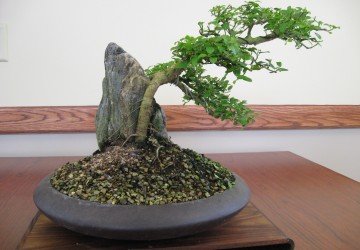
Ten Steps To Good Bonsai
Bonsai trees require a greater commitment than growing regular types of plants. Bonsai growers should always bear in mind that the appearance and age of a bonsai tree forms the basis for its price and beauty. A bonsai tree must be pruned, trimmed and shaped until the desired size and results are attained.
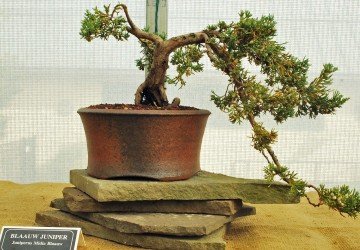
How To Revive A Bonsai Tree With Brown Leaves
Bonsai Trees are tiny versions of full-sized trees, and have gained a lot of popularity over the years. However, if they aren’t cared for properly, they could wilt or even die. Brown leaves could mean that your Bonsai is having a hard time. Regardless of why your Bonsai has brown leaves, it will need immediate attention. Recovery is not guaranteed, but this article will introduce some steps to take that might save your Bonsai Tree.

How To Keep Bonsai Tree Leaves Small
Most people know that the purpose of a bonsai tree is that the beauty of a fully-grown, aged tree is mimicked in miniature. Not only is the trunk of the tree miniaturized by specific selection, planting and pruning techniques, but so are the leaves. Without a process to encourage the growth of miniature leaves, then the bonsai tree would appear to be off-balance, and the scale of the leaves in comparison to the overall plant would completely ruin the artful effect of realism.

How To Care For A Bonsai Tree If It Looks Yellow
Sometimes a bonsai’s leaves will start to turn yellow. While some yellowing is normal, especially with certain species, too many yellow leaves could indicate a problem. If you’re a novice bonsai grower, you may be tempted to worry, but there are some tips you can follow if this begins to happen.
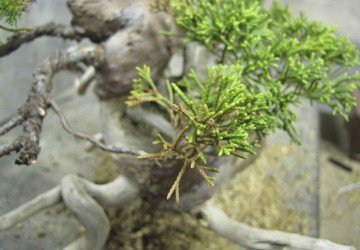
How To Care For A Sick Or Dying Juniper Bonsai Plant
Perhaps you’ve noticed your juniper bonsai looking a little under the weather. Its needles appear brown and brittle and it’s not as perky as it once was. If you suspect your little tree is experiencing distress, it is best to act very quickly. The sooner you come to your bonsai’s aid, the better.

Bonsai Tree Materials and Tools
While a plethora of materials and tools are not required, some basic materials and tools are needed to maintain the bonsai tree and craft a beautiful one. Materials for a bonsai tree include pot, humidity tray, a device to measure the water amount in the soil (rather than the chopstick method discussed above), and fertilizer. For those just starting with bonsai trees, here are some basic tools that are required.
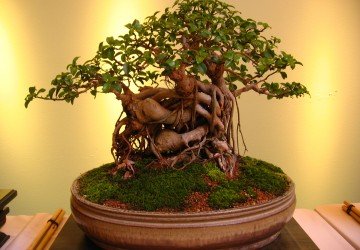
10 Things To Avoid When Growing Your Bonsai Tree
These ten simple tips will help all bonsai growers to keep their plants healthy and alive. Avoid doing these common problems and follow the advice to make the most of each bonsai tree.
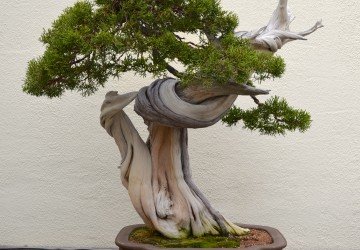
Deadwood Bonsai Techniques
Practical and aesthetic practices support the application of deadwood techniques. These old tree specimens are commonly found and collected. Dead wood can also be present on a bonsai due to pest infestation or branch die-back. It can also appear due to disease that the plant has encountered. The artist has the option to let dead wood stay on the plant or have it removed. However, removing the dead wood on the bonsai plant can harm the aged illusion it depicts.

Temperature
Bonsai trees have the same needs as other plants. They need water, light and a suitable temperature. A bonsai grower should be aware of these requirements. The success of bonsai growth depends on these factors. However, there are different types of bonsai. Each has their own needs that the grower should provide.
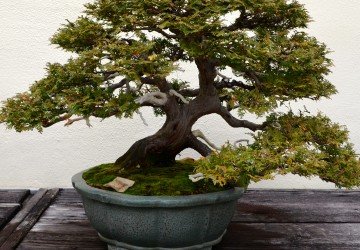
Trained Bonsai
The easiest way to get started with bonsai plants is to buy one that has already been trained. Seeds can take years to grow into full-sized plants. With trained bonsai, users have an alternative. These plants can be found at nurseries, garden centers and online stores around the country. Expertly trained professionals spend years painstakingly training the bonsai into its correct form. The only drawback for trained bonsai is the cost. Since professionals spend so many years cultivating the plants, the bonsais naturally have a higher cost.
For individuals who do not want the wait time, these plants offer an alternative. Since they are only partially-trained, owners can still shape them into the exact form that they want. With partially-trained bonsai, users get the same experience without the wait.

Harvesting Wild Plants
For the nature lover, starting a bonsai tree using a wild tree can be a very stimulating experience. Taken directly from Mother Nature, these bonsai trees let users work closely with nature and the natural shape of the plant.
When the plant is collected, users should make sure that it is done with the permission of the land’s owner. Harvest the plants early in spring and take enough of the surrounding soil so the plant does not go into shock. Over the course of a few seasons, the plant will recover enough to begin the training process. Just about any plant can be transformed into a bonsai tree, but all plants will require a significant time investment if they came from the outside world.

Air Layering
If individuals want to have a large tree within their first growing season, choosing to do air layering is an option. This propagation method involves taking a large branch or portion of a tree and using it to make an entirely new plant. Once the branch has been removed, it should be protected with sphagnum moss and wrapped in tin foil while it roots.
In roughly three to six months, the branch should have enough roots that it can be planted in a pot. Users should always use caution when doing air layering. Air layering that is not done properly can cause scars on the mother plant.

Cuttings
If a user already has a bonsai tree they love, they can take a cutting so that they can have multiple trees that are genetically identical. Compared to seeds, bonsai trees that are from cuttings take far less time and is often easier to do.
To take a cutting, users just have to cut a branch from a tree and then place it in the soil. It can also make the process of growing bonsai more efficient. Unwanted branches from older plants can be reused to create beautiful new bonsai. As users start the bonsai process, they should always try to take cuttings in the springtime. During this season, plants are already coming to life and any cutting will have a better chance at surviving.
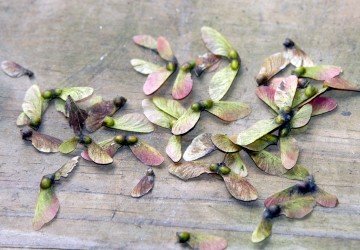
Seeds
Beginning and advanced bonsai enthusiasts often turn to seeds for starting out their bonsai plants. One of the greatest reasons for this is the drastically cheaper cost. A packet of rare bonsai seeds is much cheaper than an already trained bonsai tree.
Once the tree has started to grow, bonsai enthusiasts can completely control the entire process and put more hours into nurturing it. Many people also like the experience of watching their plant grow and transform over the years. The main negative with this method of growing bonsai is the excessive amount of time it takes. It can take plants anywhere from three to five years to grow into full bonsai when they are started from seed. For people who have the time, the joy of watching the plant transform into an aesthetic masterpiece is worth it.

Grafting
If propagating a bonsai by seed or cutting is impossible, choosing to use a grafting method is a decent alternative. This procedure entails taking a branch from the desired plant and attaching it to the potted tree. Often, nurseries will do this so that they can create huge numbers of plants in a shorter amount of time.
Unfortunately, grafting can be a cost prohibitive option. Part of this reason is because of the low success rate of the grafts. Even a professional who has had years of experience may still only get 10 to 80 percent of their grafts to grow. Since this method is highly desirable, it often fetches a higher price on the market. For individuals not concerned about the cost, grafted bonsai trees are a beautiful alternative that contains many characteristics not seen in the typical bonsai tree.
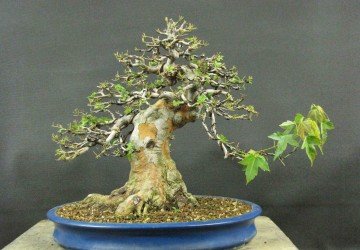
Defoliation
Defoliation is one of these techniques, and is mainly used to reduce the size of leaves. It can also stimulate growth and increase the number of leaves over time. Defoliation also stimulates production of delicate new branchlets, allowing twice the growth in a single growing season.

Clamping
In order to shape the plant the way you desire, you can use clamping to force the trunk and branches to change direction. It might already be headed a certain way, but you can change this with the right equipment. The advantage of using a clamp is that you can work with the thicker trunks that would normally be unmovable.
